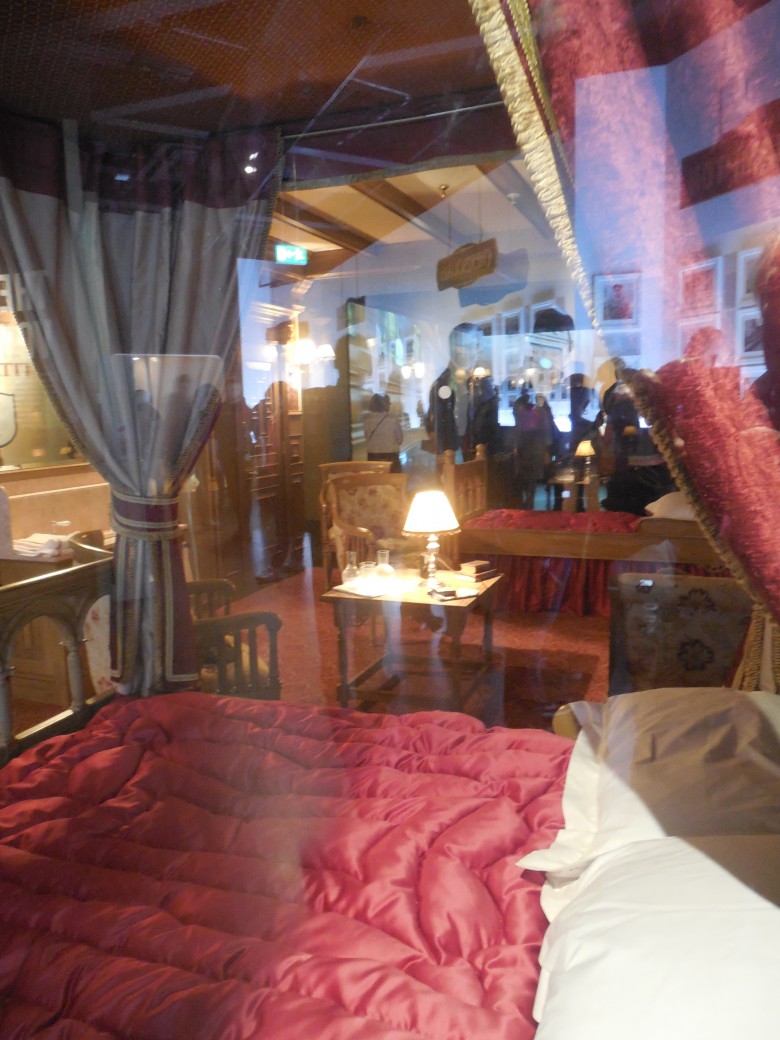Learning about the origins of the Titantic in Belfast

By Eileen Ogintz
BELFAST, Northern Ireland (Day two of Windstar cruise) — In 1907, Belfast boasted the largest docks in Ireland. More than 6,000 men worked at dangerous and low paying jobs.
James Pirrier wasn’t even 30 when he controlled Harland & Wolff, the largest shipbuilding firm in the world that was in Belfast. Over dinner, he and J. Bruce Ismay from the White Star Line collaborated to design Titanic and her sister ships—the largest and most luxurious ever built.
We are on day two of our cruise aboard the Windstar yacht Star Legend – the Gaelic Explorers tour. We’ve anchored in Portrush and taken an excursion bus for the one-hour trip to Belfast to learn about the building of the Titantic.
Here at Titanic Belfast we are right where Titanic was built A special dry dock had to be constructed—the largest in the world at the time
The museum—really an experience—shows you how the ship was built and the stories of those who built her, sailed on her ill-fated maiden voyage, perished or survived. Along with some of the world’s richest men like John Jacob Astor, there were chauffeurs and laborers, tailors and maids, and lots of children.
A photo remains of six year old Robert Douglass Spedden spinning a top in First Class.
Seven year old Eva Hardman wrote “Heaps of Love and kisses to all” to relatives. Her father had put the letter in his pocket; he draped his coat around his wife when Eva and her mother went into a lifeboat and the letter was found—it is on display here.
Two young French brothers, Michel and Edmond Navratil, were called “The Titanic Orphans” until their mother in France recognized them from newspaper photos—their father had snatched them from their home and had sailed with them under assumed names.
One nine week old baby was handed to a lifeboat in a postal bag. Milvina S. Dean lived until her 98th birthday—the last survivor when she died May 31, 2009.
We know there were only 705 survivors—more 1,500 perished, the majority from third class. There weren’t enough lifeboats; the life vests were useless in the freezing water. Most of those who died perished from hypothermia, not drowning, and, of course, the disaster changed shipboard rules forever from having enough lifeboats to making sure ships kept their communications open 24 hours
I especially liked the individual stories. William McQuillan, for example, a fireman on titanic whose was a mill worker—Belfast was the capitol of the linen manufacturing business at the time. There were stories of those you’ve never heard of–Mary Sloan who was a stewardess; Frank Brownlee, a 30 year-old textile salesman returning to Boston, and 26 year old Brigit Nilson immigrating with her husband and three children to Quebec.
Also on board there were 945 crew members.
We get a sense what it was like to work on the ship over 200 feet off the ground as we move from boomtown Belfast to the construction of the ship, the launch, the fit out, the maiden voyage, the aftermath and the Titanic beneath—nine galleries in all in what is the world’s largest Titanic Visitor experience. It allows you to literally walk in the footsteps of those who designed and built the famous ship. The audio guides certainly help.
It took 3,000 men 10 months to fit out the luxury liner after the superstructure was complete—the first class cabins had every modern convenience from hot and cold running water to electricity
Some 15,000 people worked on the Titanic; architects and draftsmen, ironwork workers and woodworkers
We see what a first class cabin would look like and feel as if we are standing on the main staircase.
Titanic left Belfast on April 2, 1912 for Southampton for her maiden voyage, where she took on cargo crew and passengers. On the morning of April 10, 930 passengers crossed the gangway. More passengers boarded in Cherbourg, France.
Frank Browne, a passenger, was sailing just from Southampton to Queenstown, Ireland, which was the last stop before the ship sailed for New York. After the disaster, his photographs were published around the world and are on display here. By the time Titanic sunk, Frank was back studying in Dublin.
We all know the story. Titanic sailed for New York on April 10, 1912 with 2,223 passengers and crew. Two nights later, she hit an iceberg and five of her 16 compartments were flooded. The ship wasn’t designed to stay afloat with more than four damaged compartments. She sank in barely three hours. A total of 1,517 people died—there were lifeboats for only 1178 but many left not full. The Carpathia rescued 713 and returned to NY.
This museum also shows us how the story was covered—hysterically! You read about the inquiries both in Britain and the U.S. about what happened and efforts to find the Titanic which culminated with its discovery by Dr. Robert Ballard in 1985, 2.5 miles below the surface of the North Atlantic.
Ballard returned in 1986 to explore and photograph the wreck with a small remotely operated sub that went inside. Here we can see on big screens and interactive computer tablets what the marine scientists have seen with previously unseen footage and a mosaic of Titanic as she currently rests–bottles laying as they must have in crates now disintegrated, a china cup, a shoe, floor tiles….
Kids can learn what it is like today to be a marine biologist or hydrographer in the Ocean Exploration Center
Outside, we can retrace the course of Titanic’s voyage on the plaza and dot and dashed shaped benches encircle the building spelling out its Morse code distress call SOS CQD. The names of survivors and victims are set in glass panels outside.
The company that built the titanic, Harland and Wolff, for example, is still flourishing—today working on renewable energy and wind turbines.




